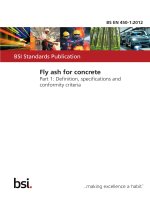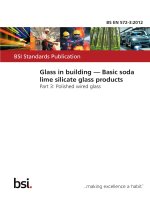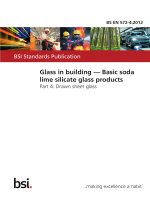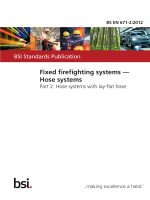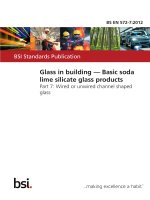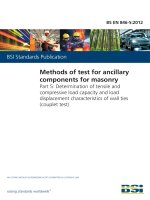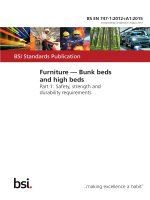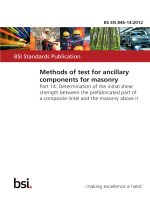Bsi bs en 62271 207 2012
Bạn đang xem bản rút gọn của tài liệu. Xem và tải ngay bản đầy đủ của tài liệu tại đây (1.63 MB, 24 trang )
BS EN 62271-207:2012
BSI Standards Publication
High-voltage switchgear
and controlgear
Part 207: Seismic qualification for
gas-insulated switchgear assemblies
for rated voltages above 52 kV
BRITISH STANDARD
BS EN 62271-207:2012
National foreword
This British Standard is the UK implementation of EN 62271-207:2012. It is
identical to IEC 62271-207:2012. It supersedes BS EN 62271-207:2007 which
is withdrawn.
The UK participation in its preparation was entrusted by Technical Committee
PEL/17, Switchgear, controlgear, and HV-LV co-ordination, to Subcommittee
PEL/17/1, High-voltage switchgear and controlgear.
A list of organizations represented on this committee can be obtained on
request to its secretary.
This publication does not purport to include all the necessary provisions of a
contract. Users are responsible for its correct application.
© The British Standards Institution 2012
Published by BSI Standards Limited 2012
ISBN 978 0 580 72474 9
ICS 29.130.10
Compliance with a British Standard cannot confer immunity from
legal obligations.
This British Standard was published under the authority of the Standards
Policy and Strategy Committee on 31 August 2012.
Amendments issued since publication
Amd. No.
Date
Text affected
BS EN 62271-207:2012
EUROPEAN STANDARD
EN 62271-207
NORME EUROPÉENNE
July 2012
EUROPÄISCHE NORM
ICS 29.130.10
Supersedes EN 62271-207:2007
English version
High-voltage switchgear and controlgear Part 207: Seismic qualification for gas-insulated switchgear assemblies
for rated voltages above 52 kV
(IEC 62271-207:2012)
Appareillage à haute tension Partie 207: Qualification sismique pour
ensembles d'appareillages à isolation
gazeuse pour des niveaux de tension
assignée supérieurs à 52 kV
(CEI 62271-207:2012)
Hochspannungs-Schaltgeräte und Schaltanlagen Teil 207: Erdbebenqualifikation für
gasisolierte Schaltgerätekombinationen
mit Bemessungsspannungen über 52 kV
(IEC 62271-207:2012)
This European Standard was approved by CENELEC on 2012-06-01. CENELEC members are bound to comply
with the CEN/CENELEC Internal Regulations which stipulate the conditions for giving this European Standard
the status of a national standard without any alteration.
Up-to-date lists and bibliographical references concerning such national standards may be obtained on
application to the CEN-CENELEC Management Centre or to any CENELEC member.
This European Standard exists in three official versions (English, French, German). A version in any other
language made by translation under the responsibility of a CENELEC member into its own language and notified
to the CEN-CENELEC Management Centre has the same status as the official versions.
CENELEC members are the national electrotechnical committees of Austria, Belgium, Bulgaria, Croatia, Cyprus,
the Czech Republic, Denmark, Estonia, Finland, Former Yugoslav Republic of Macedonia, France, Germany,
Greece, Hungary, Iceland, Ireland, Italy, Latvia, Lithuania, Luxembourg, Malta, the Netherlands, Norway, Poland,
Portugal, Romania, Slovakia, Slovenia, Spain, Sweden, Switzerland, Turkey and the United Kingdom.
CENELEC
European Committee for Electrotechnical Standardization
Comité Européen de Normalisation Electrotechnique
Europäisches Komitee für Elektrotechnische Normung
Management Centre: Avenue Marnix 17, B - 1000 Brussels
© 2012 CENELEC -
All rights of exploitation in any form and by any means reserved worldwide for CENELEC members.
Ref. No. EN 62271-207:2012 E
BS EN 62271-207:2012
EN 62271-207:2012
-2-
Foreword
The text of document 17C/542/FDIS, future edition 2 of IEC 62271-207, prepared by SC 17C “Highvoltage switchgear and controlgear assemblies”, of IEC/TC 17 "Switchgear and controlgear", was
submitted to the IEC-CENELEC parallel vote and approved by CENELEC as EN 62271-207:2012.
The following dates are fixed:
•
latest date by which the document has
to be implemented at national level by
publication of an identical national
standard or by endorsement
(dop)
2013-03-01
•
latest date by which the national
standards conflicting with the
document have to be withdrawn
(dow)
2015-06-01
This document supersedes EN 62271-207:2007.
EN 62271-207:2012 includes the following significant technical changes with respect to
EN 62271-207:2007:
-
modification of the minimum voltage rating from 72,5 kV to above 52 kV;
-
harmonisation of qualification procedures for GIS with IEEE 693:2005 Annex A and P by modifying
the response spectra;
-
modification of the test procedures;
-
addition of criteria of allowed stresses;
-
addition of dynamic analysis CQC.
Attention is drawn to the possibility that some of the elements of this document may be the subject of
patent rights. CENELEC [and/or CEN] shall not be held responsible for identifying any or all such
patent rights.
Endorsement notice
The text of the International Standard IEC 62271-207:2012 was approved by CENELEC as a
European Standard without any modification.
In the official version, for Bibliography, the following notes have to be added for the standards indicated:
IEC 61462
NOTE
Harmonized as EN 61462.
IEC 62155
NOTE
Harmonized as EN 62155.
IEC 62231
NOTE
Harmonized as EN 62231.
BS EN 62271-207:2012
EN 62271-207:2012
-3-
Annex ZA
(normative)
Normative references to international publications
with their corresponding European publications
The following documents, in whole or in part, are normatively referenced in this document and are
indispensable for its application. For dated references, only the edition cited applies. For undated
references, the latest edition of the referenced document (including any amendments) applies.
NOTE When an international publication has been modified by common modifications, indicated by (mod), the relevant EN/HD
applies.
Publication
Year
Title
IEC 60068-2-47
-
EN 60068-2-47
Environmental testing Part 2-47: Tests - Mounting of specimens for
vibration, impact and similar dynamic tests
-
IEC 60068-2-57
-
Environmental testing EN 60068-2-57
Part 2-57: Tests - Test Ff: Vibration - Timehistory method
-
IEC 60068-3-3
1991
Environmental testing Part 3: Guidance - Seismic test methods
for equipments
EN 60068-3-3
1993
IEC 62271-1
-
High-voltage switchgear and controlgear Part 1: Common specifications
EN 62271-1
-
IEC 62271-203
-
High-voltage switchgear and controlgear Part 203: Gas-insulated metal-enclosed
switchgear for rated voltages above 52 kV
EN 62271-203
-
EN/HD
Year
–2–
BS EN 62271-207:2012
62271-207 IEC:2012
CONTENTS
1
Scope ............................................................................................................................... 5
2
Normative references ....................................................................................................... 5
3
Terms and definitions ....................................................................................................... 5
4
Seismic qualification requirements ................................................................................... 6
5
4.1 General ................................................................................................................... 6
4.2 Qualification levels .................................................................................................. 6
Test procedures for qualification ....................................................................................... 6
5.1
5.2
5.3
5.4
5.5
6
General ................................................................................................................... 6
Mounting ................................................................................................................. 7
Measurements ......................................................................................................... 7
Frequency range ..................................................................................................... 7
Test severity ........................................................................................................... 7
5.5.1 General ....................................................................................................... 7
5.5.2 Parameters for time-history excitation .......................................................... 9
5.5.3 Test directions ............................................................................................. 9
5.5.4 Test sequence ............................................................................................. 9
Qualification by combined test and numerical analysis ................................................... 10
6.1
6.2
6.3
7
General ................................................................................................................. 10
Dynamic and functional data ................................................................................. 11
Numerical analysis ................................................................................................ 11
6.3.1 General ..................................................................................................... 11
6.3.2 Numerical analysis by the acceleration time-history method ...................... 11
6.3.3 Modal and spectrum analysis using the required response spectrum
(RRS) ........................................................................................................ 11
6.3.4 Static coefficient analysis .......................................................................... 12
Evaluation of the seismic qualification ............................................................................ 12
8
7.1 Combination of stresses ........................................................................................ 12
7.2 Acceptance criteria for the seismic waveform ........................................................ 13
7.3 Functional evaluation of the test results ................................................................ 13
7.4 Allowable stresses ................................................................................................ 13
Documentation ............................................................................................................... 13
8.1
8.2
8.3
Annex A
Information for seismic qualification....................................................................... 13
Test report ............................................................................................................ 14
Analysis report ...................................................................................................... 14
(normative) Characterisation of the test-set ........................................................... 15
Annex B (informative) Criteria for seismic adequacy of gas-insulated metal-enclosed
switchgear ............................................................................................................................ 17
Bibliography .......................................................................................................................... 19
Figure 1 – Required response spectrum (RRS) for qualification level moderate ...................... 8
Figure 2 – Required response spectrum (RRS) for qualification level high .............................. 9
Figure A.1 – Monogram for the determination of equivalent damping ratio ............................ 16
Table 1 – Seismic qualification levels for switchgear assemblies – Horizontal severities ......... 6
BS EN 62271-207:2012
62271-207 IEC:2012
–5–
HIGH-VOLTAGE SWITCHGEAR AND CONTROLGEAR –
Part 207: Seismic qualification for gas-insulated
switchgear assemblies for rated voltages above 52 kV
1
Scope
This part of IEC 62271 applies to gas-insulated switchgear assemblies for alternating current
of rated voltages above 52 kV for indoor and outdoor installations, including their supporting
structure.
For switchgear devices, e.g. live tank circuit breakers, IEC/TR 62271-300 is applicable.
Guidance on interactions between the supporting structure and the soil / foundations is
provided in Annex B.
The seismic qualification of the switchgear assemblies takes into account testing of typical
switchgear assemblies combined with methods of analysis. Mutual interaction between
directly mounted auxiliary and control equipment and switchgear assemblies are covered.
The seismic qualification of switchgear assemblies is only performed upon request.
2
Normative references
The following documents, in whole or in part, are normatively referenced in this document and
are indispensable for its application. For dated references, only the edition cited applies. For
undated references, the latest edition of the referenced document (including any
amendments) applies.
IEC 60068-2-47, Environmental testing – Part 2-47: Tests – Mounting of specimens for
vibration, impact and similar dynamic tests
IEC 60068-2-57, Environmental testing – Part 2-57: Tests – Test Ff: Vibration – Time-history
method
IEC 60068-3-3:1991, Environmental testing – Part 3: Guidance – Seismic test methods for
equipments
IEC 62271-1, High-voltage switchgear and controlgear – Part 1: Common specifications
IEC 62271-203, High-voltage switchgear and controlgear – Part 203: Gas-insulated metalenclosed switchgear for rated voltages above 52 kV
3
Terms and definitions
For the purposes of this document, the terms and definitions given in IEC 60068-3-3,
IEC 62271-203 and IEC 62271-1 apply.
BS EN 62271-207:2012
62271-207 IEC:2012
–6–
4
4.1
Seismic qualification requirements
General
The seismic qualification shall demonstrate the ability of the switchgear assemblies to
withstand seismic stress. It may be proofed by test or by a combination of test and analysis.
No failure on the enclosure and the main circuits as well as on the control and auxiliary
circuit, including the relevant supporting structures, shall occur.
For ductile material, minor permanent deformations are acceptable provided that they do not
impair the functionality of the equipment. The equipment shall properly operate after the
seismic event as defined in 7.2 and 7.3.
4.2
Qualification levels
The qualification has to be done on one of the recommended levels of Table 1. For vertical
severities the direction factor is 0,5.
No qualification is required for low seismic level as far as construction practice and seismic
construction practice comply with the state of the art.
Other qualification levels which consist in requirements from the customer that can be based
on specific investigation at site or regulations in national standard, taking into account for
example the type of soil, soil structure interaction, building response, and elevation may be
used.
Table 1 – Seismic qualification levels for switchgear assemblies –
Horizontal severities
Qualification
level
Required response
spectrum (RRS)
Zero period acceleration
(ZPA)
m/s 2
5
5.1
High
Figure 1
5
Moderate
Figure 2
2,5
Low
---
1
Test procedures for qualification
General
The test procedure for qualification of a test-set shall be in accordance with IEC 60068-3-3.
The qualification shall be carried out on a representative test-set.
NOTE 1 For GIS it is not possible to test a complete substation on a shake table, because of the size and weight.
Numerical analysis is always needed to give information about the seismic qualification.
The seismic test needs to be carried out under the rated filling pressure of the GIS.
The rated filling pressure in the GIS is required to test under realistic situations. Nevertheless
test laboratories for seismic testing need adequate safety measures. Test laboratories are
available in USA, Europe and Japan.
During the seismic testing no operation of the circuit breaker is necessary.
BS EN 62271-207:2012
62271-207 IEC:2012
–7–
NOTE 2 The circuit breaker operates much faster than any earthquake excitation and therefore a switching
operation has no practical impact on the test result.
If the auxiliary and control equipment or other parts of the equipment are dynamically
uncoupled, they may be qualified independently.
If a test-set cannot be tested with its supporting structure (e.g., due to its size), the dynamic
contribution of the structure shall be determined by analysis and taken into account in the
test.
The time-history test method is to be preferred, since it more closely simulates actual
conditions, particularly if the behaviour of the test-set is not linear. The test method shall be in
accordance with IEC 60068-2-57.
5.2
Mounting
The test-set shall be mounted as in service including dampers (if any).
The horizontal orientation of the test-set shall be in the direction of excitation acting along its
two main orthogonal axes.
Any fixations or connections that are required only the convenience of testing must not affect
the dynamic behaviour of the test-set.
The method of mounting of the test-set shall be documented and shall include a description of
any interposing fixtures and connections. IEC 60068-2-47 provides guidance.
5.3
Measurements
Measurements shall be performed in accordance with IEC 60068-3-3 and shall include
–
vibration motion of components where maximum deflections and significant relative
displacements are expected;
–
strains of critical elements (e.g. bushings, flanges, enclosures and support structures).
5.4
Frequency range
Frequency range shall be 0,5 Hz to 33 Hz. The frequency range is applied to the resonant
frequency search test and the generation of artificial earthquake wave.
5.5
5.5.1
Test severity
General
The test severity shall be chosen in accordance with Clause 4.
The recommended required response spectra are given in Figures 1 and 2 for the different
seismic qualification levels. The curves relate to 2 %, 5 %, 10 % of the switchgear
assemblies. If damping factor is unknown, 2 % damping is applied.
Spectra for different damping values may be obtained by linear interpolation.
BS EN 62271-207:2012
62271-207 IEC:2012
–8–
0,9
d=2
0,8
0,7
d=5
Sa (g)
0,6
d = 10
0,5
0,4
0,3
0,2
0,1
0,2
0,4
0,6
1
2
f (Hz)
4
6
10
20
40
100
IEC 694/12
Spectral Accelerations, S a (g), for Frequencies, f (Hz):
S a = 0,572 β f
for 0,0 ≤ f ≤ 1,1
S a = 0,625 β
for 1,1 ≤ f ≤ 8,0
S a = (6,6 β – 2,64) / f – 0,2 β + 0,33
for 8,0 ≤ f ≤ 33
S a = 0,25
for f > 33
β = (3,21 – 0,68 ln(d)) / 2,115 6, where d is the percent damping (2, 5, 10, etc.) and d ≤ 20 %
Figure 1 – Required response spectrum (RRS) for qualification level moderate
BS EN 62271-207:2012
62271-207 IEC:2012
–9–
1,8
d=2
1,6
1,4
d=5
1,2
d = 10
Sa (g)
1,0
0,8
0,6
0,4
0,2
0,1
0,2
0,4
0,6
1
2
f (Hz)
4
6
10
20
40
100
IEC 695/12
Spectral Accelerations, S a (g), for Frequencies, f (Hz):
S a = 1,144 β f
for 0,0 ≤ f ≤ 1,1
S a = 1,25 β
for 1,1 ≤ f ≤ 8,0
S a = (13,2 β – 5,28) / f – 0,4 β + 0,66
for 8,0 ≤ f ≤ 33
S a = 0,5
for f > 33
β = (3,21 – 0,68 ln(d)) / 2,1156, where d is the percent damping (2, 5, 10, etc.) and d ≤ 20%
Figure 2 – Required response spectrum (RRS) for qualification level high
5.5.2
Parameters for time-history excitation
The total duration of the time-history shall be about 30 s, of which the strong part shall not be
less than 20 s. The duration of strong part shall start when the time-history excitation first
reaches 25 % of its maximum acceleration. It shall end when the time-history excitation drops
below 25 % of its maximum acceleration for the last time.
5.5.3
Test directions
The test directions shall be chosen according to IEC 60068-3-3.
In some cases, the effect of the vertical acceleration results in negligible stresses and the
vertical excitation may be omitted. In such cases justification for the omission of the vertical
component shall be provided.
5.5.4
5.5.4.1
Test sequence
General
The test sequence shall be as follows:
– 10 –
BS EN 62271-207:2012
62271-207 IEC:2012
–
functional checks before testing;
–
vibration response investigation (required to determine natural frequencies and damping
ratios and/or for analysis);
–
seismic qualification test;
–
functional checks after testing.
5.5.4.2
Functional checks
Before and after the tests, the following operating characteristics or settings shall be recorded
or evaluated (when applicable) at the rated supply voltage and at rated filling pressure for
operation p rm :
a) closing time;
b) opening time;
c) time spread between units of one pole;
d) time spread between poles (if multipole tested);
e) gas and/or liquid tightness;
f)
resistance measurement of the main current path.
5.5.4.3
Vibration response investigation
The resonant frequency search test and the damping measurement test shall be carried out
according to IEC 60068-3-3 over the frequency range stated in 5.4.
5.5.4.4
Seismic qualification test
The test shall be performed by applying one of the procedures stated in the flow charts of
Annex A of IEC 60068-3-3:1991, depending on the test facilities.
The test shall be performed once at the level chosen in 4.2.
During the seismic test the following parameters shall be recorded:
–
strains of critical elements (e.g. bushings, flanges, enclosures and support structures);
–
deflection of components where significant displacements are expected;
–
electrical continuity of the main circuit (if applicable);
–
electrical continuity of the auxiliary and control circuit at the rated voltage;
–
acceleration.
6
Qualification by combined test and numerical analysis
6.1
General
The method may be used
–
to qualify switchgear assemblies already tested under different seismic conditions;
–
to qualify switchgear assemblies similar to assemblies already tested but which include
modifications influencing the dynamic behaviour (e.g. change or extension of the
arrangement or in the mass of components);
–
to qualify switchgear assemblies if their dynamic and functional data are known;
–
to qualify switchgear assemblies which cannot be qualified by testing (e.g. because of
their size, their weight or their complexity).
BS EN 62271-207:2012
62271-207 IEC:2012
6.2
– 11 –
Dynamic and functional data
Dynamic data (damping ratios, natural frequencies, stresses of critical elements as a function
of input acceleration) for analysis shall be obtained by one of the following:
a) a dynamic test of a similar test-set;
b) a dynamic test at reduced test levels;
c) determination of natural frequencies and damping ratios by other tests such as free
oscillation tests or low level excitation (see Annex A).
Functional data may be obtained from a previous test performed on a similar test-set.
6.3
Numerical analysis
6.3.1
General
The general procedure is as follows:
a) Mathematical model:
On the basis of technical information concerning the design characteristics of the
substation, a three-dimensional model of the test-set shall be created. Such a model shall
take into consideration the presence of actual compartments and of their supporting
structures, and shall have sufficient sensitivity to describe the dynamic behaviour of the
test-set in the frequency range being studied.
b) Calibration of the model:
Using experimental data stated in 6.2, the mathematical model shall be calibrated in order
to assess its dynamic characteristics. Considering the modularity of switchgear
assemblies, the mathematical model implemented and calibrated for the test-set may be
extented to a complete substation, provided that the right adaptations, related to the
structural differences existing for the different modules, are considered;
c) Response of the analysis:
The response, in the frequency range stated in 5.4, using either of the methods described
in the following subclauses has to be determined. Other methods may be used if they are
properly justified.
6.3.2
Numerical analysis by the acceleration time-history method
When the seismic analysis is carried out by the time-history method, the ground motion
acceleration time-histories shall comply with the RRS (see Table 1). Two types of
superimposition may generally be applied depending on the complexity of the analysis:
a) separate calculation of the maximum responses due to each of the three components
(x and y in the horizontal, and z in the vertical direction) of the earthquake motion. The
effects of each single horizontal direction and the vertical direction shall be combined by
taking the square root of the sum of the squares, i.e. (x 2 + z 2 ) 1/2 and (y 2 + z 2 ) 1/2 . The
greater of these two values is used for dimensioning the switchgear assemblies;
b) simultaneous calculation of the maximum responses assuming one of the seismic
horizontal directions and the vertical direction (x with z) and thereafter calculation with the
other horizontal direction and the vertical direction (y with z). This means that after each
time step of the calculation all values (forces, stresses) are superimposed algebraically.
The greater of these two values is used for dimensioning the switchgear assemblies.
6.3.3
Modal and spectrum analysis using the required response spectrum (RRS)
When the dynamic analysis is carried out by the response spectrum method, the following
shall apply:
– 12 –
BS EN 62271-207:2012
62271-207 IEC:2012
The total response of all modes in any direction shall be determined by combining all modal
response components acting in that direction using the SRSS 1 technique, except if the mode
frequencies differ by less than 10 % of the lower mode. Then these closely spaced modes are
added directly and these added modes and the remaining modes are added using the SRSS
method. Alternatively, the total response in any direction may be determined by applying the
CQC 2 technique to all modal response components acting in that direction. Sufficient modes
shall be included to ensure an adequate representation of the equipment’s dynamic response.
The acceptance criteria for establishing sufficiency in a particular direction shall be that the
cumulative participating mass of the modes considered shall be at least 90 % of the sum of
effective masses of all modes. Should the mathematical model have several resonant
frequencies above 33 Hz such that the attainment of the acceptance criteria in an orthogonal
excitation direction is impractical (as may be the case with vertical ground acceleration of
vertically stiff equipment), then the effects of the orthogonal inputs can be simulated as
follows:
a) determine the remaining effective mass in a given direction;
b) for each component, apply a static force equal to the mass of the component multiplied by
the percentage of mass missing, times the ZPA;
c) calculate stresses, reactions, and so on using these forces;
d) for each direction, combine stresses, reactions, and so on from the dynamic analysis with
those from the analysis above using the SRSS.
The maximum values in the x and z direction, and in the y and z direction, are combined by
taking the square root of the sum of the squares. The greater value of these two cases (x, z)
or (y, z) is the dimensioning factor for the switchgear assemblies.
6.3.4
Static coefficient analysis
The static coefficient analysis allows a simpler technique in return for added conservatism. No
determination of natural frequencies is made but, rather, the response spectrum of the
switchgear assemblies is assumed to be the peak of the required response spectrum at a
conservative and justifiable value of damping. The coefficient 1,5 shall be applied to static
coefficient analysis.
The seismic forces on each part of the switchgear assemblies are obtained by multiplying the
values of the mass, concentrated at its centre of gravity, and the acceleration.
The resulting force shall be distributed proportionally to the mass distribution.
The stress analysis may then be completed as stated in 7.1.
If the lowest resonant frequency of equipment is greater than 33 Hz, the equipment may be
called rigid. A static analysis may be applied using the ZPA of the response spectrum and a
static coefficient of 1,0.
7
Evaluation of the seismic qualification
7.1
Combination of stresses
The seismic stresses determined by test or analysis shall be combined algebraically with
other service loads to determine the total withstand capability of the switchgear assemblies.
The probability of an earthquake of the recommended seismic qualification level occurring
during the life-time of the switchgear assemblies is low, whilst the maximum seismic load in a
———————
1
Square Root of the Sum of Squares
2
Complete Quadratic Combination
BS EN 62271-207:2012
62271-207 IEC:2012
– 13 –
natural earthquake would only occur if the switchgear assemblies were excited at their natural
frequencies with maximum acceleration. Since any excitation at natural frequencies will last
for a few seconds at most, a combination of the utmost electrical and environmental service
loads leads to unrealistic conservatism.
The following loads may be considered to occur additionally, if not otherwise specified:
–
rated filling pressure for operation prm ;
–
permanent loads (dead loads);
–
thermal effects.
The combination of loads shall be effected by static analysis, applying the forces in the
direction they occur.
7.2
Acceptance criteria for the seismic waveform
The seismic simulation waveform shall produce a test response spectrum which envelopes
the required response spectrum (calculated at the same damping ratio). The peak
acceleration shall be equal to or greater than the zero period acceleration. Also, the
limitations of the test facility shall be considered to the extent permitted by 5.4. Further
acceptance criteria for the seismic waveform are given in IEC 60068-2-57.
7.3
Functional evaluation of the test results
Functional results are normally obtained only by dynamic tests. These results may be
extrapolated to obtain qualification by combination of tests and analysis. In particular,
a) the main contacts shall remain in open or closed position during the seismic test;
b) chatter of relays shall not cause the switching devices to operate;
c) chatter of relays shall not provide wrong information of the status of the switchgear
assemblies (position, alarm signals);
NOTE
Normally, chatter of relays lasting less than 5 ms is considered to be acceptable.
d) resetting of monitoring equipment is considered to be acceptable if the overall
performance of the switchgear assemblies is not affected;
e) no significant change shall occur in functional check recordings at the end of the test
sequence compared with the initial ones (see 5.5.4.2);
f)
7.4
no cracking or buckling shall be found on the equipment and equipment supports.
Allowable stresses
The allowable stress of enclosures shall not exceed 100 % of the materials yield stress. For
supporting structures made from ductile material, stresses greater 100 % yield stress and
plastic deformation are acceptable if it does not impact the functionality of the equipment. For
other material the allowable stress must remain within the limits for the exceptional load case
given by established standards.
NOTE For instance components made of cast epoxy resins, ceramic material or glass may be stressed up to
100 % of their type test withstand bending moment, see IEC 62155; components made of composite material may
be stressed up to their specified cantilever load (SCL) or specified mechanical load (SML), see IEC 62231 and
IEC 61462 respectively.
8
8.1
Documentation
Information for seismic qualification
The following information is required for either analysis or testing of the switchgear
assemblies:
– 14 –
BS EN 62271-207:2012
62271-207 IEC:2012
a) qualification level (see 4.2);
b) details of structure and mounting (see 5.1 and 5.2);
c) number and relative position of testing axes (see 5.2);
8.2
Test report
The test report shall contain the following items:
a) switchgear assemblies identification file including structure and mounting details;
b) test dates, recordings and videos;
c) applicable standards;
d) wave form of the time history;
e) test facility
1) location,
2) test equipment description and calibration,
3) accreditation of the test laboratory;
f)
test method and procedures;
g) placement of strain gauge/acceleration sensors;
h) pressure gauges;
i)
test data including functional data (see 5.5.4.2 and 6.2);
j)
results and conclusions;
k) approved signature and date.
8.3
Analysis report
Analysis, which is included as a proof of performance, shall have a step-by-step presentation.
The analysis report shall contain the following items:
a) general and global assumptions;
b) software package used including version number;
c) employed method (see Clause 6);
d) switchgear assemblies identification file including structure and mounting details;
e) information about required response spectra and qualification levels;
f)
natural frequencies and damping ratio;
g) load combinations;
h) results and conclusions;
i)
applicable standards.
BS EN 62271-207:2012
62271-207 IEC:2012
– 15 –
Annex A
(normative)
Characterisation of the test-set
A.1
A.1.1
Low-level excitation
General
The method exploits the application of a low-level excitation of the test-set for the
determination of its natural response.
A.1.2
Test method
When portable exciter is used, experimenters must pay attention to the influence of the weight
of portable exciters. With the test-set mounted to simulate the recommended service
mounting conditions, a number of portable exciters are attached at the points on the test-set
which will best excite its various modes of vibration.
The data obtained from the monitoring instruments placed on the test-set may be used to
analyse its dynamic performance.
A.1.3
Analysis
The frequency responses obtained from the test are used to determine the modal frequencies
and damping ratios which shall be used in the dynamic analysis of the test-set stated in
Clause 6. This method provides a greater degree of certainty in analysis since the analytical
model is refined to reflect the measured natural frequencies and experimental damping ratios.
A.2
A.2.1
Free oscillation test
General
Free oscillation tests may be used for the identification of the dynamic behaviour of a test-set
that can be modelled as a single degree of freedom system (e.g. the bushings).
A.2.2
Natural frequency determination
To determine the natural frequency (first vibration mode) the test-set, fully arranged for
service, shall be fixed to a rigid foundation by the recommended means.
The arbitrary force magnitude shall be used when sufficient measuring deformation is
obtained.
The arbitrary force shall be applied at the vicinity of gravity centre or at any place where the
sufficient measuring deformation is obtained (such as free end of equipment).
A.2.3
Determination of the damping ratio by the logarithmic decrement method
To determine the damping ratio of the test-set, the same test may be used. A number of
oscillations shall be recorded with suitable sensitivity and accuracy. Those oscillations are
then used to determine the logarithmic decrement of the oscillations as a function of time. The
equivalent damping ratio is determined using the monogram of Figure A.1, taken from the
sequence of peaks in the recorded wave in that range of the record in which the logarithmic
decrement appears most clear.
BS EN 62271-207:2012
62271-207 IEC:2012
– 16 –
Alternatively, the following equation can be used to determine the damping ratio ς:
1
ς=
2π ⋅ n
1+
ln Y0
Y
n
2
where
n
is the number of oscillations;
Y n /Y 0
is the peak ratio.
A.2.4
Special cases regarding the determination of natural frequencies and damping
ratios
The test-set may consist of different elements and each of these elements may be susceptible
to vibration. In this case, the tests described in A.2.2 and A.2.3 shall be carried out by
applying tensile forces to each centre of gravity. The vibrations of each of these centres of
gravity shall then be recorded together with the oscillation modes of the entire arrangement.
Especially when elements of the arrangement show similar natural frequencies, resonances
and beats in the oscillogram may further complicate the determination of damping ratios.
When that happens, a centre line may be used in order to determine the damping ratio. The
use of a centre line has been indicated in the sketch shown at the top of Figure A.1.
100
YYnn
YY00
Centre
centre line
line
nn == 0,5
0.5
10
Damping (%)
nn == 11
nn == 22
nn == 55
1
nn == 10
10
Y00
nn == 20
20
Ynn
n=5
0,1
1
0,8
0,6
0,4
0,2
0
Peak ratio Yn/Y0
IEC 696/12
Figure A.1 – Monogram for the determination of equivalent damping ratio
BS EN 62271-207:2012
62271-207 IEC:2012
– 17 –
Annex B
(informative)
Criteria for seismic adequacy of gas-insulated
metal-enclosed switchgear
B.1
General
By the regulations of this standard the seismic qualification of gas-insulated switchgear
assemblies can be proved. Generally those assemblies are an integrated part of an
environment to which they have effect and, in reverse, from which they are affected. The
following clauses therefore are indicating how influences from soil, foundations and buildings
should be regarded. Recommendations are made how to treat anchorage and bracings on
switchgear structures and how to deal with the interconnection of adjacent equipment.
B.2
Soil-structure interaction
Soil-structure interaction occurs when the soil deforms due to the loading to the soil from the
equipment-foundation system responding to an earthquake. The soil-foundation system may
become a significant component in the dynamic properties of the equipment-foundations-soil
system, which may increase or decrease the motion the equipment experiences during an
earthquake. Soil-structure interaction occurs with certain combinations of equipment mass
and size, foundation type and configuration, and soil properties. Transformers and liquid-filled
reactors are especially susceptible to soil-structure interaction. The rocking motion of
transformers can cause increased acceleration and displacement of components high in the
equipment, such as bushings and lightning arresters. Soil-structure interaction is generally not
considered in the design of substation equipment, unless specifically requested by the user. It
increases where there are high accelerations, heavy equipment, high centres of gravity, or
soft sites.
B.3
Elevation factor
The amplification of the ground acceleration resulting from the behaviour of buildings and
structures shall be regarded. Where no information is available the amplification may be
accounted for by means of an elevation factor. The recommended values are given in
IEC 60068-3-3:1991, Table 4 but a relevant specification may prescribe other values for given
site conditions.
B.4
Foundations
It is recommended that, as far as possible, all interconnected equipment be placed on a
monolithic foundation to reduce differential movements due to the design earthquake. When
interconnected equipment is not located on the same foundation, then the expected
differential motions between equipment due to foundation motion shall be provided.
Consideration may be given to soil interaction on underground conduits entering and leaving
through the foundations. If equipment is rigidly coupled to structural elements, such as walls
or adjacent floors, the element response and relative motion may be taken into account.
B.5
Methods for anchoring equipment to foundations
It is strongly recommended that large equipment and equipment with large dimensions
between anchor locations be anchored to steel members imbedded in and firmly attached to
– 18 –
BS EN 62271-207:2012
62271-207 IEC:2012
structural elements in the concrete. Location and type of fixings may be shown on the
manufacturer’s drawing. All fixings shall be adequate for forces coming from a design
earthquake. Exposed fixings may have a protective coating.
If bolts are used to anchor equipment, they shall be either cast in fresh concrete or fixed by
means of well-tested chemical anchors for drilled holes in hardened concrete. The use of
bolts or anchors that are placed in holes drilled in hardened concrete is not recommended.
Bolts of mild, ductile steel are preferred.
Consideration may be given to any unequal distribution of dynamic earthquake loading on the
anchor bolts (due to bolt hole tolerance, torque load or non-contact of nut). The torque value
to which the anchor bolts are tightened, their size and location, shall be shown on the
construction drawings. In addition, the strength and material specifications shall be provided.
All anchor systems shall be designed to accommodate torsion, shear and bending and axial
loads and any combination thereof that is experienced during the design earthquake. Shear
and tensile strength of that portion of the anchor system within the foundation may be greater
than the strength of the bolt attaching to the equipment.
B.6
Interconnection to adjacent equipment
All interconnections between equipment shall be adequate to accommodate all large relative
motions.
Structurally and dynamically dissimilar equipment may experience large relative displacements. Interconnections shall be long and flexible enough to allow these displacements to
occur without causing damage. Particular attention shall be paid to brittle non-ductile parts
such as ceramic bushings and insulators. In no circumstances shall electrical or structural
interconnections abruptly stiffen leading to increased motion and strain. Such nonlinearities
develop large impact forces. The changing dynamic characteristic between sections or
equipment shall be considered.
B.7
Use of bracings on switchgear structure
Stiffening the equipment may increase some of its natural frequencies, raising them out of the
critical range of earthquake energy. Diagonal cross-bracing and axial load-carrying members
can be used to stiffen or strengthen equipment. Where bracing is employed, particular
attention should be paid to the following aspects:
–
bolted joints are recommended throughout the structure so as to increase the effective
damping at high force levels;
–
information concerning the correct torque for all bolts shall be supplied, thus ensuring the
assemblies will behave dynamically as intended;
–
if part of the structure is to be supplied by the user, then the manufacturer or user, or
both, shall supply the necessary information so that the static and dynamic
characteristics and foundation requirements can be easily determined.
The following basic requirements on the bracing should be taken into account:
–
the bracing shall be substantially stiffer than the structure it reinforces so as to be
effective;
–
the bracing shall not buckle or exhibit a sharply nonlinear behaviour. In particular, any
abrupt stiffening under any circumstance is to be avoided;
–
permanent deformation in the bracing after a design earthquake is acceptable provided
that it does not impair normal functioning of the GIS.
BS EN 62271-207:2012
62271-207 IEC:2012
– 19 –
Bibliography
[1]
IEC 61462, Composite hollow insulators – Pressurized and unpressurized insulators for
use in electrical equipment with rated voltage greater than 1 000 V – Definitions, test
methods, acceptance criteria and design recommendations
[2]
IEC/TS 61463, Bushings – Seismic qualification
[3]
IEC 62155, Hollow pressurized and unpressurized ceramic and glass insulators for use
in electrical equipment with rated voltages greater than 1 000 V
[4]
IEC 62231, Composite station post insulators for substations with a.c voltages greater
than 1 000 V up to 245 kV – Definitions, test methods and acceptance criteria
[5]
IEC/TR 62271-300, High-voltage switchgear and controlgear − Part 300: Seismic
qualification of alternating current circuit-breakers
[6]
IEEE 693:2005, IEEE Recommended Practices for Seismic Design of Substations
[7]
IEEE C37.122:1993, IEEE Standard for Gas-Insulated Substations
___________
This page deliberately left blank
This page deliberately left blank
NO COPYING WITHOUT BSI PERMISSION EXCEPT AS PERMITTED BY COPYRIGHT LAW
British Standards Institution (BSI)
BSI is the national body responsible for preparing British Standards and other
standards-related publications, information and services.
BSI is incorporated by Royal Charter. British Standards and other standardization
products are published by BSI Standards Limited.
About us
Revisions
We bring together business, industry, government, consumers, innovators
and others to shape their combined experience and expertise into standards
-based solutions.
Our British Standards and other publications are updated by amendment or revision.
The knowledge embodied in our standards has been carefully assembled in
a dependable format and refined through our open consultation process.
Organizations of all sizes and across all sectors choose standards to help
them achieve their goals.
Information on standards
We can provide you with the knowledge that your organization needs
to succeed. Find out more about British Standards by visiting our website at
bsigroup.com/standards or contacting our Customer Services team or
Knowledge Centre.
Buying standards
You can buy and download PDF versions of BSI publications, including British
and adopted European and international standards, through our website at
bsigroup.com/shop, where hard copies can also be purchased.
If you need international and foreign standards from other Standards Development
Organizations, hard copies can be ordered from our Customer Services team.
Subscriptions
Our range of subscription services are designed to make using standards
easier for you. For further information on our subscription products go to
bsigroup.com/subscriptions.
With British Standards Online (BSOL) you’ll have instant access to over 55,000
British and adopted European and international standards from your desktop.
It’s available 24/7 and is refreshed daily so you’ll always be up to date.
You can keep in touch with standards developments and receive substantial
discounts on the purchase price of standards, both in single copy and subscription
format, by becoming a BSI Subscribing Member.
PLUS is an updating service exclusive to BSI Subscribing Members. You will
automatically receive the latest hard copy of your standards when they’re
revised or replaced.
To find out more about becoming a BSI Subscribing Member and the benefits
of membership, please visit bsigroup.com/shop.
With a Multi-User Network Licence (MUNL) you are able to host standards
publications on your intranet. Licences can cover as few or as many users as you
wish. With updates supplied as soon as they’re available, you can be sure your
documentation is current. For further information, email
BSI Group Headquarters
389 Chiswick High Road London W4 4AL UK
We continually improve the quality of our products and services to benefit your
business. If you find an inaccuracy or ambiguity within a British Standard or other
BSI publication please inform the Knowledge Centre.
Copyright
All the data, software and documentation set out in all British Standards and
other BSI publications are the property of and copyrighted by BSI, or some person
or entity that owns copyright in the information used (such as the international
standardization bodies) and has formally licensed such information to BSI for
commercial publication and use. Except as permitted under the Copyright, Designs
and Patents Act 1988 no extract may be reproduced, stored in a retrieval system
or transmitted in any form or by any means – electronic, photocopying, recording
or otherwise – without prior written permission from BSI. Details and advice can
be obtained from the Copyright & Licensing Department.
Useful Contacts:
Customer Services
Tel: +44 845 086 9001
Email (orders):
Email (enquiries):
Subscriptions
Tel: +44 845 086 9001
Email:
Knowledge Centre
Tel: +44 20 8996 7004
Email:
Copyright & Licensing
Tel: +44 20 8996 7070
Email:
